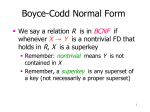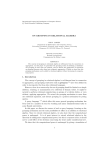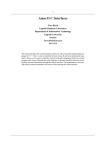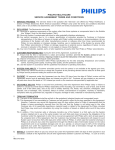Download 01.03.2012
Transcript
Design Techniques 1. Avoid redundancy 2. Limit the use of weak entity sets 3. Don’t use an entity set when an attribute will do 1 Avoiding Redundancy § Redundancy = saying the same thing in two (or more) different ways § Wastes space and (more importantly) encourages inconsistency § Two representations of the same fact become inconsistent if we change one and forget to change the other § Recall anomalies due to FD’s 2 Example: Good name Beers name ManfBy addr Manfs This design gives the address of each manufacturer exactly once 3 Example: Bad name Beers name ManfBy addr Manfs manf This design states the manufacturer of a beer twice: as an attribute and as a related entity. 4 Example: Bad name manf manfAddr Beers This design repeats the manufacturer’s address once for each beer and loses the address if there are temporarily no beers for a manufacturer 5 Entity Sets Versus Attributes § An entity set should satisfy at least one of the following conditions: § It is more than the name of something; it has at least one nonkey attribute or § It is the “many” in a many-one or manymany relationship 6 Example: Good name Beers name ManfBy addr Manfs • Manfs deserves to be an entity set because of the nonkey attribute addr • Beers deserves to be an entity set because it is the “many” of the many-one relationship ManfBy 7 Example: Good name manf Beers There is no need to make the manufacturer an entity set, because we record nothing about manufacturers besides their name 8 Example: Bad name Beers name ManfBy Manfs Since the manufacturer is nothing but a name, and is not at the “many” end of any relationship, it should not be an entity set 9 Don’t Overuse Weak Entity Sets § Beginning database designers often doubt that anything could be a key by itself § They make all entity sets weak, supported by all other entity sets to which they are linked § In reality, we usually create unique ID’s for entity sets § Examples include CPR numbers, car’s license plates, etc. 10 When Do We Need Weak Entity Sets? § The usual reason is that there is no global authority capable of creating unique ID’s § Example: it is unlikely that there could be an agreement to assign unique player numbers across all football teams in the world 11 From E/R Diagrams to Relations § Entity set → relation § Attributes → attributes § Relationships → relations whose attributes are only: § The keys of the connected entity sets § Attributes of the relationship itself 12 Entity Set → Relation name manf Beers Relation: Beers(name, manf) 13 Relationship → Relation name husband addr Drinkers 1 name Likes manf Beers 2 Buddies Favorite wife Married Likes(drinker, beer) Favorite(drinker, beer) Buddies(name1, name2) Married(husband, wife) 14 Combining Relations § OK to combine into one relation: 1. The relation for an entity-set E 2. The relations for many-one relationships of which E is the “many” § Example: Drinkers(name, addr) and Favorite(drinker, beer) combine to make Drinker1(name, addr, favBeer) 15 Risk with Many-Many Relationships § Combining Drinkers with Likes would be a mistake. It leads to redundancy, as: name Peter Peter addr Campusvej Campusvej beer Od.Cl. Erd.W. Redundancy 16 Handling Weak Entity Sets § Relation for a weak entity set must include attributes for its complete key (including those belonging to other entity sets), as well as its own, nonkey attributes § A supporting relationship is redundant and yields no relation (unless it has attributes) 17 Example: Weak Entity Set → Relation name expiry Logins name At Hosts location Hosts(hostName, location) Logins(loginName, hostName, expiry) At(loginName, hostName, hostName2) At becomes part of Logins Must be the same 18 Subclasses: Three Approaches 1. Object-oriented : One relation per subset of subclasses, with all relevant attributes 2. Use nulls : One relation; entities have NULL in attributes that don’t belong to them 3. E/R style : One relation for each subclass: § Key attribute(s) § Attributes of that subclass 19 Example: Subclass → Relations name Beers manf isa color Ales 20 Object-Oriented name manf Odense Classic Albani Beers name manf HC Andersen Albani Ales color red Good for queries like “find the color of ales made by Albani” 21 E/R Style name manf Odense Classic Albani HC Andersen Albani Beers name HC Andersen color red Ales Good for queries like “find all beers (including ales) made by Albani” 22 Using Nulls name Odense Classic HC Andersen manf Albani Albani Beers color NULL red Saves space unless there are lots of attributes that are usually NULL 23 Summary 6 More things you should know: § Entities, Attributes, Entity Sets, § Relationships, Multiplicity, Keys § Roles, Subclasses, Weak Entity Sets § Design guidelines § E/R diagrams → relational model 24 The Project 25 Purpose of the Project § To try in practice the process of designing and creating a relational database application § This process includes: § development of an E/R model § transfer to the relational model § normalization of relations § implementation in a DBMS § programming of an application 26 Project as part of The Exam § Part of the exam and grading! § The project must be done individually § No cooperation is allowed beyond what is explicitly stated in the description 27 Subject of the Project § To create an electronic inventory for a computer store § Keep information about complete computer systems and components § System should be able to § calculate prices for components and computer systems § make lists of components to order from the distributor 28 Objects of the System § component: name, kind, price § kind is one of CPU, RAM, graphics card, mainboard, case § CPU: socket, bus speed § RAM: type, bus speed § mainboard: CPU socket, RAM type, onboard graphics?, form factor § case: form factor 29 Objects of the System § computer system: catchy name, list of components § requires a case, a mainboard, a CPU, RAM, optionally a graphics card § sockets, bus speed, RAM type, and form factor must match § if there is no on-board graphics, a graphics card must be included 30 Objects of the System § current stock: list of components and their current amount § minimum inventory: list of components, their allowed minimum amount, and their preferred amount after restocking 31 Intended Use of the System § Print a daily price list for components and computer systems § Give quotes for custom orders § Print out a list of components for restocking on Saturday morning (computer store restocks his inventory every Saturday at his distributor) 32 Selling Price § Selling price for a component is the price + 30% § Selling price for a computer system is sum of the selling prices of the components rounded up to next ’99‘ § Rebate System: § total price is reduced by 2% for each additional computer system ordered § maximal 20% rebate 33 Example: Selling Price § computer system for which the components are worth DKK 1984 § the selling price of the components is 1984*1.3 = 2579.2 § It would be sold for DKK 2599 § Order of 3 systems: DKK 7485, i.e., DKK 2495 per system § Order of 11, 23, or 42 systems: DKK 2079 per system 34 Functionality of the System § List of all components in the system and their current amount § List of all computer systems in the system and how many of each could be build from the current stock § Price list including all components and their selling prices grouped by kind all computers systems that could be build from the current stock including their 35 components and selling price Functionality of the System § Price offer given the computer system and the quantity § Sell a component or a computer system by updating the current stock § Restocking list including names and amounts of all components needed for restocking to the preferred level 36 Limitations for the Project § No facilities for updating are required except for the Selling mentioned explicitly § Only a simple command-line based interface for user interaction is required § Choices by the user can be input by showing a numbered list of alternatives or by prompting for component names, etc. § You are welcome to include update facilities or make a better user interface 37 but this will not influence the final grade! Tasks 1. Develop an appropriate E/R model 2. Transfer to a relational model 3. Ensure that all relations are in 3NF (decompose and refine the E/R model) 4. Implement in PostgreSQL DBMS (ensuring the constraints hold) 5. Program in Java or Python an application for the user interaction providing all functionality from above 38 Test Data § Can be made up as you need it § At least in the order of 8 computer systems and 30 components § Sharing data with other participants in the course is explicitly allowed and encouraged 39 Formalities § Printed report of approx. 10 pages § design choices and reasoning § structure of the final solution § Must include: § A diagram of your E/R model § Schemas of your relations § Arguments showing that these are in 3NF § Central parts of your SQL code + explanation § A (very) short user manual for the application § Documentation of testing 40 Milestones § There are two stages: 1. Tasks 1-3, deadline March 11 Preliminary report describing design choices, E/R model, resulting relational model (will be commented on and handed back) 2. Tasks 4-5, deadline March 25 Final report as correction and extension of the preliminary report § Grade for the project will be based both on the preliminary and on the final report 41 Implementation § Java with fx JDBC as DB interface § Python with fx psycopg2 as DB interface § SQL and Java/Python code handed in electronically with report in Blackboard § Database for testing must be available on the PostgreSQL server § Testing during grading will use your program and the data on that server 42 Constraints 43 Constraints and Triggers § A constraint is a relationship among data elements that the DBMS is required to enforce § Example: key constraints § Triggers are only executed when a specified condition occurs, e.g., insertion of a tuple § Easier to implement than complex constraints 44 Kinds of Constraints § Keys § Foreign-key, or referential-integrity § Value-based constraints § Constrain values of a particular attribute § Tuple-based constraints § Relationship among components § Assertions: any SQL boolean expression 45 Review: Single-Attribute Keys § Place PRIMARY KEY or UNIQUE after the type in the declaration of the attribute § Example: CREATE TABLE Beers ( name CHAR(20) PRIMARY KEY, manf CHAR(20) ); 46 Review: Multiattribute Key § The bar and beer together are the key for Sells: CREATE TABLE Sells ( bar CHAR(20), beer VARCHAR(20), price REAL, PRIMARY KEY (bar, beer) ); 47 Foreign Keys § Values appearing in attributes of one relation must appear together in certain attributes of another relation § Example: in Sells(bar, beer, price), we might expect that a beer value also appears in Beers.name 48 Expressing Foreign Keys § Use keyword REFERENCES, either: 1. After an attribute (for one-attribute keys) 2. As an element of the schema: FOREIGN KEY (<list of attributes>) REFERENCES <relation> (<attributes>) § Referenced attributes must be declared PRIMARY KEY or UNIQUE 49 Example: With Attribute CREATE TABLE Beers ( name CHAR(20) PRIMARY KEY, manf CHAR(20); CREATE TABLE Sells ( bar CHAR(20), beer CHAR(20) REFERENCES Beers(name), price REAL ); 50 Example: As Schema Element CREATE TABLE Beers ( name CHAR(20) PRIMARY KEY, manf CHAR(20) ); CREATE TABLE Sells ( bar CHAR(20), beer CHAR(20), price REAL, FOREIGN KEY(beer) REFERENCES Beers(name)); 51 Enforcing Foreign-Key Constraints § If there is a foreign-key constraint from relation R to relation S, two violations are possible: 1. An insert or update to R introduces values not found in S 2. A deletion or update to S causes some tuples of R to “dangle” 52 Actions Taken § Example: suppose R = Sells, S = Beers § An insert or update to Sells that introduces a non-existent beer must be rejected § A deletion or update to Beers that removes a beer value found in some tuples of Sells can be handled in three ways (next slide) 53 Actions Taken 1. Default: Reject the modification 2. Cascade: Make the same changes in Sells § Deleted beer: delete Sells tuple § Updated beer: change value in Sells 3. Set NULL: Change the beer to NULL 54 Example: Cascade § Delete the Od.Cl. tuple from Beers: § Then delete all tuples from Sells that have beer = ’Od.Cl.’ § Update the Od.Cl. tuple by changing ’Od.Cl.’ to ’Odense Classic’: § Then change all Sells tuples with beer = ’Od.Cl.’ to beer = ’Odense Classic’ 55 Example: Set NULL § Delete the Od.Cl. tuple from Beers: § Change all tuples of Sells that have beer = ’Od.Cl.’ to have beer = NULL § Update the Od.Cl. tuple by changing ’Od.Cl.’ to ’Odense Classic’: § Same change as for deletion 56 Choosing a Policy § When we declare a foreign key, we may choose policies SET NULL or CASCADE independently for deletions and updates § Follow the foreign-key declaration by: ON [UPDATE, DELETE][SET NULL CASCADE] § Two such clauses may be used § Otherwise, the default (reject) is used 57 Example: Setting Policy CREATE TABLE Sells ( bar CHAR(20), beer CHAR(20), price REAL, FOREIGN KEY(beer) REFERENCES Beers(name) ON DELETE SET NULL ON UPDATE CASCADE ); 58 Attribute-Based Checks § Constraints on the value of a particular attribute § Add CHECK(<condition>) to the declaration for the attribute § The condition may use the name of the attribute, but any other relation or attribute name must be in a subquery 59 Example: Attribute-Based Check CREATE TABLE Sells ( bar CHAR(20), beer CHAR(20) CHECK (beer IN (SELECT name FROM Beers)), price INT CHECK (price <= 100) ); 60 Timing of Checks § Attribute-based checks are performed only when a value for that attribute is inserted or updated § Example: CHECK (price <= 100) checks every new price and rejects the modification (for that tuple) if the price is more than 100 § Example: CHECK (beer IN (SELECT name FROM Beers)) not checked if a beer is deleted from Beers (unlike foreign-keys) 61 Tuple-Based Checks § CHECK (<condition>) may be added as a relation-schema element § The condition may refer to any attribute of the relation § But other attributes or relations require a subquery § Checked on insert or update only 62 Example: Tuple-Based Check § Only Carlsens Kvarter can sell beer for more than 100: CREATE TABLE Sells ( bar CHAR(20), beer CHAR(20), price REAL, CHECK (bar = ’C4’ OR price <= 100) ); 63 Assertions § These are database-schema elements, like relations or views § Defined by: CREATE ASSERTION <name> CHECK (<condition>); § Condition may refer to any relation or attribute in the database schema 64 Example: Assertion § In Sells(bar, beer, price), no bar may charge an average of more than 100 CREATE ASSERTION NoRipoffBars CHECK ( NOT EXISTS ( Bars with an average price SELECT bar FROM Sells above 100 GROUP BY bar HAVING 100 < AVG(price) )); 65 Example: Assertion § In Drinkers(name, addr, phone) and Bars(name, addr, license), there cannot be more bars than drinkers CREATE ASSERTION LessBars CHECK ( (SELECT COUNT(*) FROM Bars) <= (SELECT COUNT(*) FROM Drinkers) ); 66 Timing of Assertion Checks § In principle, we must check every assertion after every modification to any relation of the database § A clever system can observe that only certain changes could cause a given assertion to be violated § Example: No change to Beers can affect FewBar; neither can an insertion to Drinkers 67 Triggers 68 Triggers: Motivation § Assertions are powerful, but the DBMS often cannot tell when they need to be checked § Attribute- and tuple-based checks are checked at known times, but are not powerful § Triggers let the user decide when to check for any condition 69 Event-Condition-Action Rules § Another name for “trigger” is ECA rule, or event-condition-action rule § Event: typically a type of database modification, e.g., “insert on Sells” § Condition: Any SQL boolean-valued expression § Action: Any SQL statements 70 Preliminary Example: A Trigger § Instead of using a foreign-key constraint and rejecting insertions into Sells(bar, beer, price) with unknown beers, a trigger can add that beer to Beers, with a NULL manufacturer 71 Example: Trigger Definition The event CREATE TRIGGER BeerTrig AFTER INSERT ON Sells REFERENCING NEW ROW AS NewTuple FOR EACH ROW The condition WHEN (NewTuple.beer NOT IN (SELECT name FROM Beers)) INSERT INTO Beers(name) The action VALUES(NewTuple.beer); 72 Options: CREATE TRIGGER § CREATE TRIGGER <name> § or CREATE OR REPLACE TRIGGER <name> § Useful if there is a trigger with that name and you want to modify the trigger 73 Options: The Event § AFTER can be BEFORE § Also, INSTEAD OF, if the relation is a view § A clever way to execute view modifications: have triggers translate them to appropriate modifications on the base tables § INSERT can be DELETE or UPDATE § And UPDATE can be UPDATE . . . ON a particular attribute 74 Options: FOR EACH ROW § Triggers are either “row-level” or “statement-level” § FOR EACH ROW indicates row-level; its absence indicates statement-level § Row level triggers: execute once for each modified tuple § Statement-level triggers: execute once for a SQL statement, regardless of how many tuples are modified 75 Options: REFERENCING § INSERT statements imply a new tuple (for row-level) or new table (for statement-level) § The “table” is the set of inserted tuples § DELETE implies an old tuple or table § UPDATE implies both § Refer to these by [NEW OLD][TUPLE TABLE] AS <name> 76 Options: The Condition § Any boolean-valued condition § Evaluated on the database as it would exist before or after the triggering event, depending on whether BEFORE or AFTER is used § But always before the changes take effect § Access the new/old tuple/table through the names in the REFERENCING clause 77 Options: The Action § There can be more than one SQL statement in the action § Surround by BEGIN . . . END if there is more than one § But queries make no sense in an action, so we are really limited to modifications 78 Another Example § Using Sells(bar, beer, price) and a unary relation RipoffBars(bar), maintain a list of bars that raise the price of any beer by more than 10 79 The Trigger The event – only changes to prices CREATE TRIGGER PriceTrig AFTER UPDATE OF price ON Sells REFERENCING Updates let us talk about old Condition: OLD ROW AS ooo and new tuples a raise in NEW ROW AS nnn We need to consider price > 10 each price change FOR EACH ROW WHEN (nnn.price > ooo.price + 10) INSERT INTO RipoffBars When the price change is great enough, add VALUES (nnn.bar); the bar to RipoffBars 80 SQL vs PostgreSQL 81 Checks in PostgreSQL § Tuple-based checks may only refer to attributes of that relation § Attribute-based checks may only refer to the name of the attribute § No subqueries allowed! § Use triggers for more elaborate checks 82 Assertions in PostgreSQL § Assertions are not implemented! § Use attribute-based or tuple-based checks where possible § Use triggers for more elaborate checks 83 Triggers in PostgreSQL § PostgreSQL does not allow events for only certain columns § Rows and tables are called OLD and NEW (no REFERENCING ... AS) § PostgreSQL only allows to execute a function as the action statement 84 The Trigger – SQL The event – only changes to prices CREATE TRIGGER PriceTrig AFTER UPDATE OF price ON Sells REFERENCING Updates let us talk about old Condition: OLD ROW AS ooo and new tuples a raise in NEW ROW AS nnn We need to consider price > 10 each price change FOR EACH ROW WHEN (nnn.price > ooo.price + 10) INSERT INTO RipoffBars When the price change is great enough, add VALUES (nnn.bar); the bar to RipoffBars 85 The Trigger – PostgreSQL CREATE TRIGGER PriceTrigger AFTER UPDATE ON Sells FOR EACH ROW EXECUTE PROCEDURE checkRipoff(); The event – any changes to Sells Updates have fixed references OLD and NEW We need to consider each price change Conditions moved into function Always check for a ripoff using a function 86 The Function – PostgreSQL Conditions moved into function CREATE FUNCTION CheckRipoff() RETURNS TRIGGER AS $$BEGIN IF NEW.price > OLD.price+10 THEN INSERT INTO RipoffBars When the price change is great enough, add the bar to RipoffBars VALUES (NEW.bar); END IF; Updates have fixed references RETURN NEW; OLD and NEW END$$ LANGUAGE plpgsql; 87 Functions in PostgreSQL § CREATE FUNCTION name([arguments]) RETURNS [TRIGGER type] AS $$function definition$$ LANGUAGE lang; § Example: CREATE FUNCTION add(int,int) RETURNS int AS $$select $1+$2;$$ LANGUAGE SQL; § CREATE FUNCTION add(i1 int,i2 int) RETURNS int AS $$BEGIN RETURN i1 + i2; END;$$ LANGUAGE plpgsql; 88 Example: Attribute-Based Check CREATE TABLE Sells ( bar CHAR(20), beer CHAR(20) CHECK (beer IN (SELECT name FROM Beers)), price INT CHECK (price <= 100) ); 89 Example: Attribute-Based Check CREATE TABLE Sells ( bar CHAR(20), beer CHAR(20), price INT CHECK (price <= 100)); CREATE FUNCTION CheckBeerName() RETURNS TRIGGER AS $$BEGIN IF NOT NEW.beer IN (SELECT name FROM Beers) THEN RAISE EXCEPTION ‘no such beer in Beers’; END IF; RETURN NEW; END$$ LANGUAGE plpgsql; CREATE TRIGGER BeerName AFTER UPDATE OR INSERT ON Sells FOR EACH ROW EXECUTE PROCEDURE CheckBeerName(); 90 Example: Assertion § In Drinkers(name, addr, phone) and Bars(name, addr, license), there cannot be more bars than drinkers CREATE ASSERTION LessBars CHECK ( (SELECT COUNT(*) FROM Bars) <= (SELECT COUNT(*) FROM Drinkers) ); 91 Example: Assertion CREATE FUNCTION CheckNumbers() RETURNS TRIGGER AS $$BEGIN IF (SELECT COUNT(*) FROM Bars) > (SELECT COUNT(*) FROM Drinkers) THEN RAISE EXCEPTION ‘2manybars’; END IF; RETURN NEW; END$$ LANGUAGE plpgsql; CREATE TRIGGER NumberBars AFTER INSERT ON Bars EXECUTE PROCEDURE CheckNumbers(); CREATE TRIGGER NumberDrinkers AFTER DELETE ON Drinkers EXECUTE PROCEDURE 92 CheckNumbers(); Checks in PostgreSQL § Tuple-based checks may only refer to attributes of that relation § Attribute-based checks may only refer to the name of the attribute § No subqueries allowed! § Use triggers for more elaborate checks 93 Assertions in PostgreSQL § Assertions are not implemented! § Use attribute-based or tuple-based checks where possible § Use triggers for more elaborate checks 94 Triggers in PostgreSQL § PostgreSQL does not allow events for only certain columns § Rows and tables are called OLD and NEW (no REFERENCING ... AS) § PostgreSQL only allows to execute a function as the action statement 95 The Trigger – SQL The event – only changes to prices CREATE TRIGGER PriceTrig AFTER UPDATE OF price ON Sells REFERENCING Updates let us talk about old Condition: OLD ROW AS ooo and new tuples a raise in NEW ROW AS nnn We need to consider price > 10 each price change FOR EACH ROW WHEN (nnn.price > ooo.price + 10) INSERT INTO RipoffBars When the price change is great enough, add VALUES (nnn.bar); the bar to RipoffBars 96 The Trigger – PostgreSQL CREATE TRIGGER PriceTrigger AFTER UPDATE ON Sells FOR EACH ROW EXECUTE PROCEDURE checkRipoff(); The event – any changes to Sells Updates have fixed references OLD and NEW We need to consider each price change Conditions moved into function Always check for a ripoff using a function 97 The Function – PostgreSQL Conditions moved into function CREATE FUNCTION CheckRipoff() RETURNS TRIGGER AS $$BEGIN IF NEW.price > OLD.price+10 THEN INSERT INTO RipoffBars When the price change is great enough, add the bar to RipoffBars VALUES (NEW.bar); END IF; Updates have fixed references RETURN NEW; OLD and NEW END$$ LANGUAGE plpgsql; 98 Functions in PostgreSQL § CREATE FUNCTION name([arguments]) RETURNS [TRIGGER type] AS $$function definition$$ LANGUAGE lang; § Example: CREATE FUNCTION add(int,int) RETURNS int AS $$select $1+$2;$$ LANGUAGE SQL; § CREATE FUNCTION add(i1 int,i2 int) RETURNS int AS $$BEGIN RETURN i1 + i2; END;$$ LANGUAGE plpgsql; 99 Example: Attribute-Based Check CREATE TABLE Sells ( bar CHAR(20), beer CHAR(20) CHECK (beer IN (SELECT name FROM Beers)), price INT CHECK (price <= 100) ); 100 Example: Attribute-Based Check CREATE TABLE Sells ( bar CHAR(20), beer CHAR(20), price INT CHECK (price <= 100)); CREATE FUNCTION CheckBeerName() RETURNS TRIGGER AS $$BEGIN IF NOT NEW.beer IN (SELECT name FROM Beers) THEN RAISE EXCEPTION ‘no such beer in Beers’; END IF; RETURN NEW; END$$ LANGUAGE plpgsql; CREATE TRIGGER BeerName AFTER UPDATE OR INSERT ON Sells FOR EACH ROW EXECUTE PROCEDURE CheckBeerName(); 101 Example: Assertion § In Drinkers(name, addr, phone) and Bars(name, addr, license), there cannot be more bars than drinkers CREATE ASSERTION LessBars CHECK ( (SELECT COUNT(*) FROM Bars) <= (SELECT COUNT(*) FROM Drinkers) ); 102 Example: Assertion CREATE FUNCTION CheckNumbers() RETURNS TRIGGER AS $$BEGIN IF (SELECT COUNT(*) FROM Bars) > (SELECT COUNT(*) FROM Drinkers) THEN RAISE EXCEPTION ‘2manybars’; END IF; RETURN NEW; END$$ LANGUAGE plpgsql; CREATE TRIGGER NumberBars AFTER INSERT ON Bars EXECUTE PROCEDURE CheckNumbers(); CREATE TRIGGER NumberDrinkers AFTER DELETE ON Drinkers EXECUTE PROCEDURE 103 CheckNumbers();

















































































































